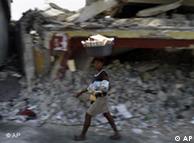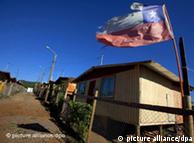NATURAL DISASTERS | 16.06.2011
Risk index maps world's disaster hot spots
When an earthquake rocked the Caribbean island republic of Haiti in early 2010, hundreds of thousands of people died, while hundreds of thousands more lost their homes.
Just a few weeks later, the earth shook in the central coastal region of the South American nation of Chile. There, jolts reached 8.8 on the Richter scale, compared with the 7.0 earthquake in Haiti.
Yet in Chile, far fewer people died – 500 instead of the 200,000 who lost their lives in Haiti.
Global risk index
Extreme natural events don't lead to the same level of disaster in every country. The reasons for this, and what can be done to reduce society's vulnerability, are the subject of the "WorldRiskReport."
In their report, the Alliance Development Works – a federation of several German aid agencies – along with the United Nations University in Bonn, calculated a natural disaster risk value for 173 countries worldwide.
At highest risk for natural disasters is the Pacific island state Vanuatu. At lowest risk, the emirate of Qatar. Germany is only slightly at risk, with a ranking of 150.
 Developing countries are hotspots for natural disasters.A glance at the map reflecting global risk shows that the highest peril is to developing countries. The greatest danger for natural disasters to wreak havoc exists above all in Asia and Latin America, including the Philippines, Bangladesh, Cambodia, Guatemala and El Salvador.
Developing countries are hotspots for natural disasters.A glance at the map reflecting global risk shows that the highest peril is to developing countries. The greatest danger for natural disasters to wreak havoc exists above all in Asia and Latin America, including the Philippines, Bangladesh, Cambodia, Guatemala and El Salvador.Also especially prone to disasters are African countries. There are hardly any, or very few, state-sponsored preparations to combat the effects of natural disasters. The global risk index reaffirms the importance of crisis prevention, but it also highlights something else - when it comes to disasters, it's poverty that kills.
Unequal effects
At first glance, it appears to be a miracle that 400 times fewer people died in Chile than in Haiti when one of the strongest earthquakes of the past century shook the densely populated central Chilean coast in February 2010. But on closer inspection, Chile was clearly better prepared.
Chile has an efficient public sector, the government takes measures against corruption, earthquake-proof building codes have been tightened in recent years, and – perhaps most importantly – those regulations were enforced.
Furthermore, the population was trained for natural disasters through drills.
Development variables
The range of natural disasters, be they earthquakes, hurricanes or floods, that threaten a region are only part of a region's vulnerability, according to Peter Mucke, director of Alliance Development Works.
Other variables include a country's leadership and its overall level of development. Housing conditions, nutritional standards and levels of medical care all play an important role in limiting death tolls in the aftermath of a disaster.
"And of course it's important, that the government stands ready to invest in precautionary measures," he added. A woman walks by a house destroyed in the 2010 earthquake in Haiti.
A woman walks by a house destroyed in the 2010 earthquake in Haiti.
 A woman walks by a house destroyed in the 2010 earthquake in Haiti.
A woman walks by a house destroyed in the 2010 earthquake in Haiti.Long-term investment in prevention
Katrin Radtke, with the relief agency Welthungerhilfe, says public thinking also has to change. Disasters should be viewed as long term, multi-faceted challenges rather than short term calamities.
"It's important to get involved in the long term, and support affected communities so they can better manage disasters," Radtke said.
Overcoming immediate problems is also important, but doesn't necessarily improve resilience in the long run, she says.
"We're trying to prevent a disaster, by being active over a period of time in a country."
Peter Mucke, also hopes to make media, politicians and private donors rethink the issue, because – as in medicine – prevention is usually the cheapest cure.
Author: Nils Naumann (sd)
Editor: Nathan Witkop
Editor: Nathan Witkop











No comments:
Post a Comment